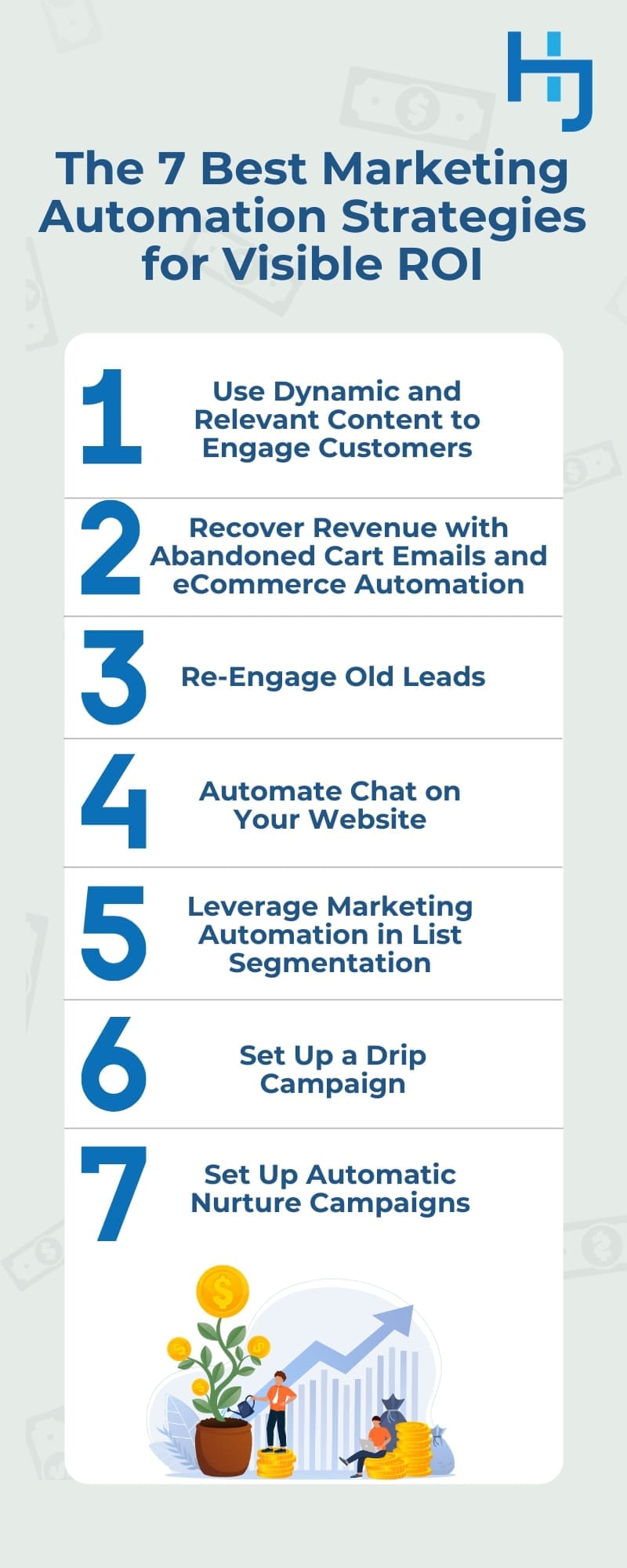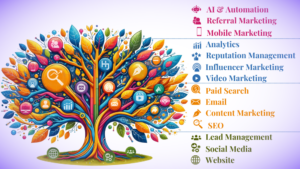 About half of all businesses are leveraging at least some marketing automation strategies today, and more than half say they plan to increase automation spend next year, according to the latest Forrester report. Yet, many initiatives stall out due to lack of planning, trouble getting the right people in place to implement, or not having the right resources.
About half of all businesses are leveraging at least some marketing automation strategies today, and more than half say they plan to increase automation spend next year, according to the latest Forrester report. Yet, many initiatives stall out due to lack of planning, trouble getting the right people in place to implement, or not having the right resources.
In this article, I’ll walk you through the basics and cover some of the most impactful marketing automation strategies and tools that can help, so you can start implementing the techniques and getting results right away.
What is Marketing Automation and How Does it Work?
Marketing automation allows businesses to put repetitive tasks on autopilot and market on multiple channels more effectively.
Automated Marketing Tools
Many tools on the market today can help automate marketing processes. Some address a lot of areas, and others specialize in a specific medium or channel.
For example, most people have heard of HubSpot and Salesforce. These are marketing platforms that house many different tools, including CRM, forms, landing pages, and email marketing. Plus, they allow you to automate processes within each hub.
Options like MailChimp and Constant Contact can also help you automate, but they’re primarily focused on email automation.
You’ll find specialty software that can help with social media, SMS marketing, ads, forms, and more.
Instructions (Workflows)
Once you’ve selected a marketing tool, you can begin programming it to carry out tasks for you. The detailed instructions you give it will come in the form of “workflows.” A workflow uses a trigger or if/then statement to identify when a task needs to be performed and then executes it according to your instructions.
For example, you might want to connect your forms to your CRM so that all leads are automatically imported. In this case, your “trigger” will be the submission of a new lead form, and the action is importing the form data to your CRM.
You might then want to assign leads to a specific sales rep. For example, you might use an if/then statement. “If the product involved is a widget, Then assign the lead to the widget sales specialist.”
Workflows can be simple like this, or they may be quite involved. For example, a workflow may also segment your lead and place them on a specific mailing list, then kick off a series of emails. Automation can also be used to change course when a contact takes a specific action, such as clicking a link or even removing someone from a list when they make a purchase.
You’ll be amazed by the number of tasks and processes you can automate once you dip your toes in the automation pool! In addition, you can layer in automation at every stage of the buyer’s journey to strengthen all your sales and marketing efforts.
Why Do Businesses Use Marketing Automation?
You may already be excited by all the possibilities made available through marketing automation, but it’s not just bells and whistles. There’s a massive business case for it too.
Efficiency
The amount of time saved varies depending on your automation strategy’s volume and maturity. A company using automation purely to add leads to its CRM could save minutes per day or hours per day, depending on lead volume. A company automating hundreds of processes and emails will save much more time than one merely using automation to add leads to the CRM.
Lead Qualification
Sometimes a human touch is vital to closing a deal. A strong automation strategy will monitor leads across all your channels and score them, so reps can focus on those most likely to convert.
Nurturing and Conversion
Leads often grow cold without some kind of nurturing program. After all, human reps can only make so many calls and send so many emails in a day. Instead, businesses automate these follow-ups to keep leads moving through the sales funnel to conversion. By the same token, automation can be used to segment leads and create personalized journeys to improve conversions as well.
Tracking and Improving Results
With the right tools and processes in place, businesses can get a high-level overview of what’s happening with their leads to spot leaks in their funnels and make improvements. A/B testing can also be used with automation to improve results over time.
Moreover, this data can be used to prove the effectiveness of marketing campaigns and demonstrate the value the marketing team is bringing to the organization.
Boosting Return on Marketing Investment (ROMI)
By empowering businesses through data-driven marketing and boosting efficiency, return on marketing investment (ROMI) naturally improves too. Businesses leveraging marketing automation see a 14.5 percent increase in sales productivity and a 12.2 percent reduction in marketing overhead, according to Salesforce data. Their research also shows it can increase sales opportunities by 20 percent and boost qualified leads by 451 percent!
The 7 Best Marketing Automation Strategies for Visible ROI

With so many ways to leverage automation, which marketing automation strategies should businesses leverage first? Below, I’ll explore seven proven tactics that can serve as good starting points.
Strategy #1: Use Dynamic and Relevant Content to Engage Customers
Think of a typical visitor journey and imagine that you’re searching for business lending solutions. You type “business loan options” in the search bar and go to a page that outlines many different ways your business can raise capital. This static content is helpful and engages you. However, you also notice that the sidebar mentions your city and lists lenders or loan packages that can meet your needs. It’s easy to see how the sidebar content will nudge you to action. This is dynamic content.
Eight in ten consumers are more likely to do business with a company that offers personalized experiences, according to Search Engine Journal. Their research shows that 52 percent of customers expect personalized offers and that emails with personalized subject lines are 26 percent more likely to be opened too.
Strategy #2: Recover Revenue with Abandoned Cart Emails and eCommerce Automation
You probably have personal experience with e-commerce automation if you’ve ever shopped online with any major store. One of the most common strategies is the use of dynamic content, as explored above. For example, you may look at a pair of boots online and then see those boots everywhere you go online for weeks or receive emails that showcase the boots and similar products afterward.
Abandoned cart emails work similarly. Again, you can start by reminding the customer that they’ve left something behind or pair it with a special offer, such as a percent discount or free shipping.
Around half of all abandoned cart emails are opened, according to Moosend research. Half of those opened are clicked on, and half of those clicks become purchases. You’re leaving money on the table if you aren’t already leveraging abandoned cart emails.
Strategy #3: Re-Engage Old Leads
It costs money to generate leads, so it’s essential to ensure each one gets the follow-up it deserves. You can do this through time delays with your marketing automation software. For example, you may want to set an email to go out 30 days after a lead failed to take action. You can also have your CRM fire off a task for a sales rep to contact the lead if their deal stays at a certain stage for a pre-determined period of time.
Strategy #4: Automate Chat on Your Website
Seven in ten customers want to resolve most customer service issues on their own, and roughly the same say they interact with an intelligent assistant or chatbot at least once a month, according to Customer Think research. Chatbots are great for reducing customer journey friction and moving people through your funnel, all while lightening the load for your sales and support teams.
Strategy #5: Leverage Marketing Automation in List Segmentation
Your campaigns will perform better when the content is tailored to the recipient. One way to approach this is through list segmentation in your email program.
- Engagement: If your email program permits, you can automatically have people placed on a specific list when they take a particular action. You can also use lead scoring to send different messages to people depending on their level of interest.
- Status: If your company is subscription-based, it’s always a good idea to split out your active clients from previous or inactive ones. You might also segment based on purchase volume, subscription tier, or similar.
- Persona or Role: B2B companies should be especially mindful about segmenting by role. Oftentimes, you’ll be “selling” to someone who is not a decision-maker who needs a different message than someone who can give the final ok. Your audience will have different concerns, pain points, and needs, so segmenting by persona can be helpful across the board too.
- Industry: Segmenting by industry allows you to send more tailored content from time to time instead of general interest pieces, which will keep your audience more engaged.
- Interest: If you offer more than one product or service, segment based on interest to provide information that’s specific to what they want to know about.
- Location: Many businesses overlook the importance of segmenting by location, particularly if their offerings are similar across a wide geographic area. However, segmenting by location allows you to capitalize on what’s happening locally for them, be it new legislation, competitors entering the market or other events.
Strategy #6: Set Up a Drip Campaign
Drip campaigns and nurturing campaigns are often used interchangeably, but they have different purposes and goals.
- Drip campaigns are time-based. You send your contact a specific chain of emails over a set period of time regardless of their actions. A contact doesn’t leave a drip unless they unsubscribe.
- Nurturing campaigns are behavior-based. You send your contact a series of emails based on actions such as link clicks, form fills, page views, webinar signups, and things of the like. A contact can leave a nurturing campaign if they unsubscribe or complete a specific action.
With this in mind, you may create a drip campaign to showcase a new product or service. You can also use drips to onboard new clients or help them get the most out of your products and services. For example:
- Day 1: Welcome!
- Day 2: Getting Started Resources
- Day 4: Product FAQs
- Day 7: Tips and Tricks
- Day 10: Let Us Know How You’re Doing
- Day 20: Advanced Resources
Strategy #7: Set Up Automatic Nurture Campaigns
It’s best practice to pair your drip campaigns with nurturing campaigns. Again, nurturing campaigns are based on user behavior, so two contacts may have different experiences depending on what they do.
Some potential triggers for nurturing campaigns include:
- Filling out a form on your website.
- Completing a purchase.
- Visiting a specific page on your website.
- Engaging with your chatbot.
- Downloading content.
- Attending or registering for a virtual event.
In these cases, you might use lead scoring to bump someone over to a new workflow or send them a different email, depending on whether they opened or clicked the last one. In doing so, you can carry people through your funnel and tailor their content to where they are in their journey.
Get Help Shoring Up Your Marketing Automation Strategies
I build automation into everything I do as a digital marketing consultant. It helps improve the effectiveness of campaigns and boosts ROMI. Plus, it helps teams work more efficiently and allows them to focus more on the people and tasks that need their attention most. If you’re not automating yet or aren’t sure you’re leveraging marketing automation to its fullest, I can help. Contact me for a complimentary consultation.





































































